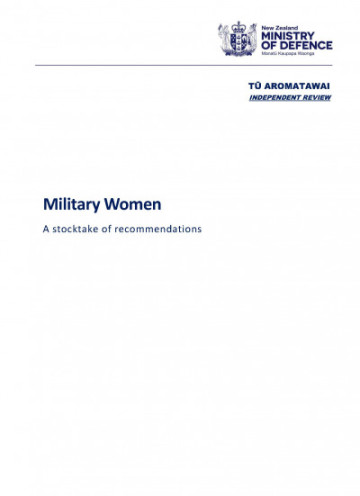
Published: 17 Dec 2019
Category: Publication
The 'Military Women: A stocktake of recommendations' reviewed the uptake of the recommendations from the 2014 review 'Maximising opportunities for Military Women in the New Zealand Defence Force (NZDF)', also known as the Military Women report.
Download PDF 658 KBAdditional info
Additional info
The 2014 publication Maximising opportunities for Military Women in the NZDF (“Military Women”) assessed what the NZDF were doing to ensure women were able to achieve their full potential, as well as exploring ways as to how this could be improved. This 2018 stocktake review measured the extent of the uptake of the original recommendations, and analysed the content of the NZDF reports to the Organisation Committee that covered the implementation of recommendations from the review.
It was important to reassess the 2014 recommendations for a range of reasons, including:
- how women are treated in the NZDF represents an important strategic risk for NZDF
- the review assessed whether women in the Regular Force were treated equitably, able to reach their full potential and safe from harassment, bullying and assault. All of these elements are crucial in ensuring women succeed in the workplace, and
- the review was conducted in 2014, and four years is ample time for the recommendations to be implemented or progressed.
The 2014 review grouped the overall recommendations into four themes:
- Recruit the best personnel, by focusing on a broader potential candidate pool
- Expand systems to increase retention
- Improve pathways for women to attain senior leadership
- Further reduce discrimination, harassment and bullying, particularly in recruit training
The stocktake review describes each in-progress recommendation in detail, the improvement made since 2014 and possible further steps to usefully implement the recommendation.
The stocktake review found that NZDF had completed 11 of the 25 recommendations, with 13 “in progress”, and one superseded. While progress has been made, implementation of the Military Women review recommendations has progressed more slowly than anticipated.
The stocktake review suggests the NZDF focus on:
- using the Military Women report and recommendations to focus on shifting culture
- building the organisational stamina required to shift culture by:
- providing consistent and adequate resources
- supporting middle managers to implement and embed change, and
- adopting a whole of organisation focus.
© Crown Copyright
This copyright work is licensed under the Creative Commons Attribution 4.0 International licence. In essence, you are free to copy, distribute and adapt the work, as long as you attribute the work to the Ministry of Defence and abide by the other licence terms. 12
